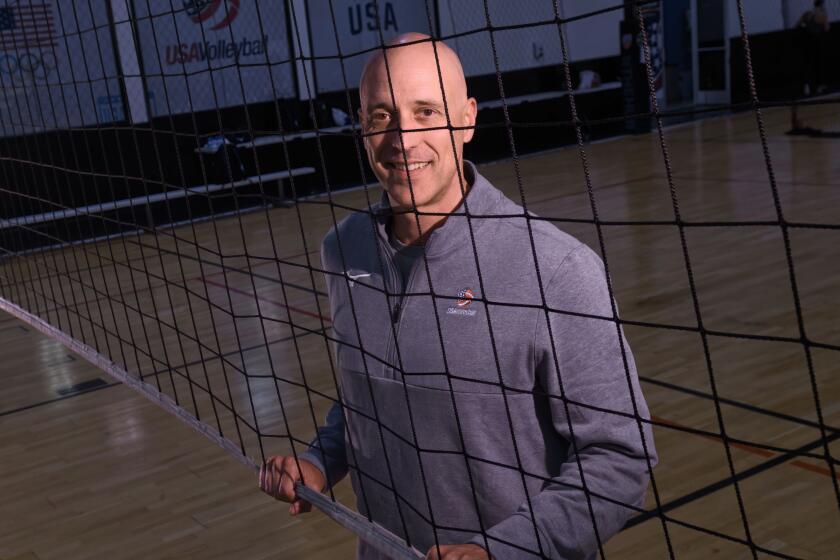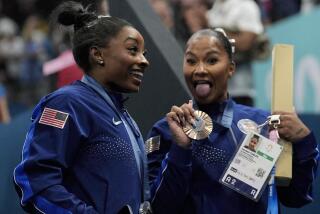
- Share via
The most decorated gymnast ever sprints down the vault runway. She tumbles gracefully onto the springboard, flings herself backward onto the vault table and pops off the surface. Soaring through the air, she folds her body in half and grabs the back of her legs for two head-over-heels flips.
The crowd erupts when Simone Biles stomps her feet into the mat.
Another successful Yurchenko double pike.
“It just makes your mouth drop open every time,” said UCLA gymnastics coach Janelle McDonald, who sat in the front row next to the vault landing area at the U.S. Olympic trials, where Biles competed her signature vault.
Of the five skills in the International Gymnastics Federation (FIG) code of points named after Biles, her most recent vault — the Yurchenko double pike — has become the most iconic.
It’s the first major leap in vault innovation for women’s artistic gymnastics in two decades. When leveling up the sky-high event used to mean extra twists, Biles flipped the game upside down. She was the first woman to attempt her double-flipping skill in competition and completed it in international competition for the first time at the 2023 World Championships, earning its name as the Biles II.
“Simone made impossible an opinion with that vault,” NBC analyst John Roethlisberger said on the telecast during the U.S. Olympic trials.
In a sport that blends power and grace, Biles’ Yurchenko double pike is at the center of its own Venn diagram: athletic feat, scientific marvel and artistic genius all in six seconds.
The entry
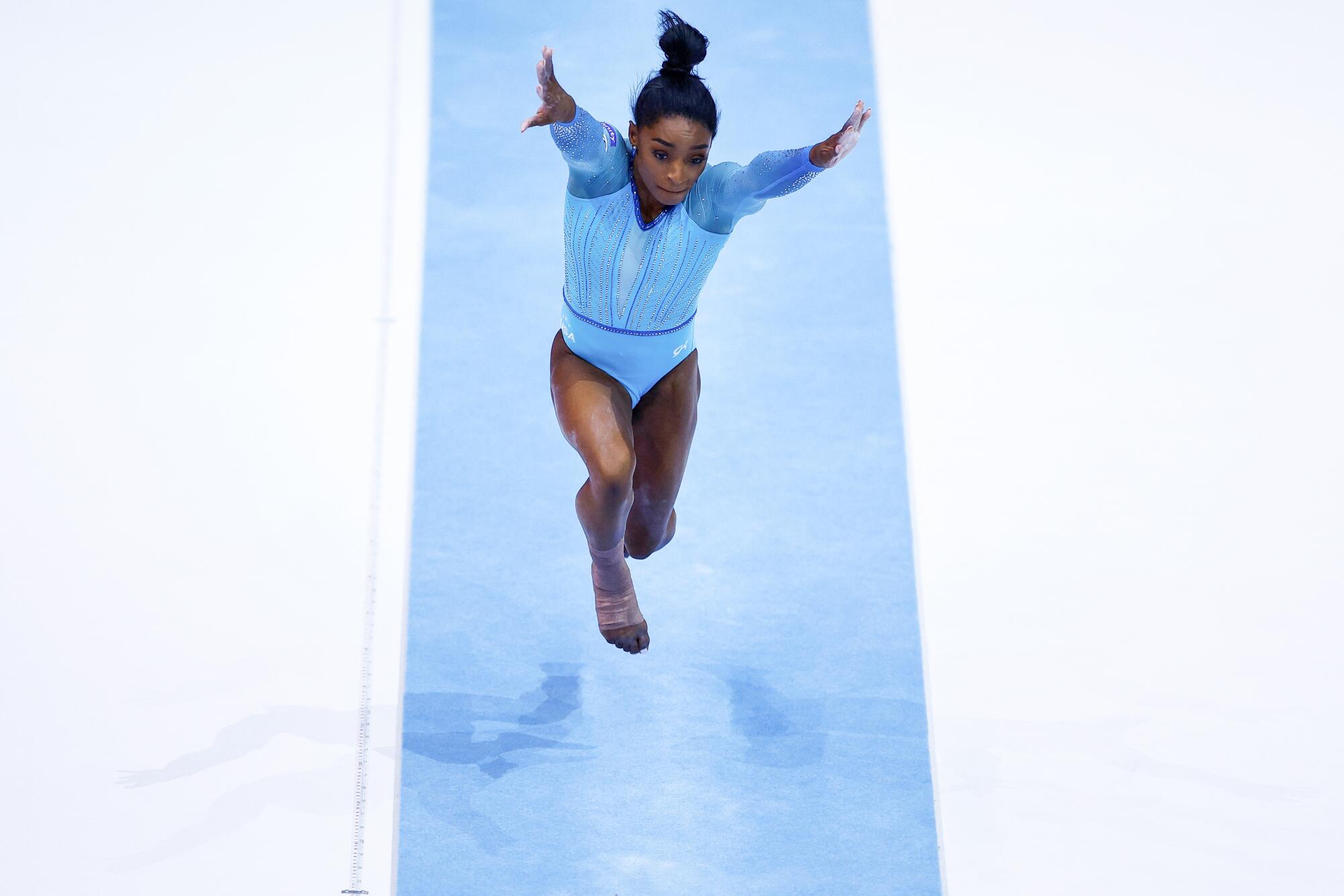
The height, the rotation and the landing earn the most gasps from the fans who follow Biles’ every move on the competition floor. But for her peers who continue to marvel at the 27-year-old’s revolutionary talent, the most impressive part of the vault happens before Biles even contacts the table.
“Your Yurchenko entry has to be so technically perfect and so consistent,” said 2016 Olympic gold medalist Kyla Ross. “You have no doubt coming off the table that you’re going to hit the double pike.”
The Yurchenko entry — a roundoff onto the springboard and a back handspring onto the vault table — is named after former Russian gymnast Natalia Yurchenko, who debuted her eponymous skill in 1982. Since the FIG replaced the vault horse — which resembled a pommel horse without handles and was about 5 feet long and 1 foot wide at the top — for a tongue-shaped vault table in 2001, the Yurchenko vault has become more common for elite female gymnasts. Athletes can still harness the power generated from the unique entry while having a larger, safer surface area for their hands.
Biles begins with a sprint down the runway and reaches her hands toward the ground while cartwheeling her legs over her head. The roundoff turns her momentum forward to backward. Slamming her feet down on the springboard, Biles compresses the springs that then uncoil and transfer energy back into her body as she reaches up and backward for the vault table.
The key to vault liftoff is how Biles contacts the equipment to transfer her momentum.
“Pre-springboard, all of their motion is forwards,” said Emily Kuhn, a physics PhD student at Yale who was a level 10 gymnast. “After the springboard, some of their motion is upwards. And so [the board is] really helpful for converting the rotational energy from that roundoff into an upwards velocity that is used to get the height on the vault.”
In an instant, Biles arches backward toward the vault table. Her body whips back in a lightning-fast handspring that leaves even the best athletes in the world in the dust.
“She gets that power because of how quick-twitched her roundoff-back handspring is, technically speaking,” said 2008 Olympic silver medalist Samantha Peszek. “No one is as quick-twitch as Simone.”
The block
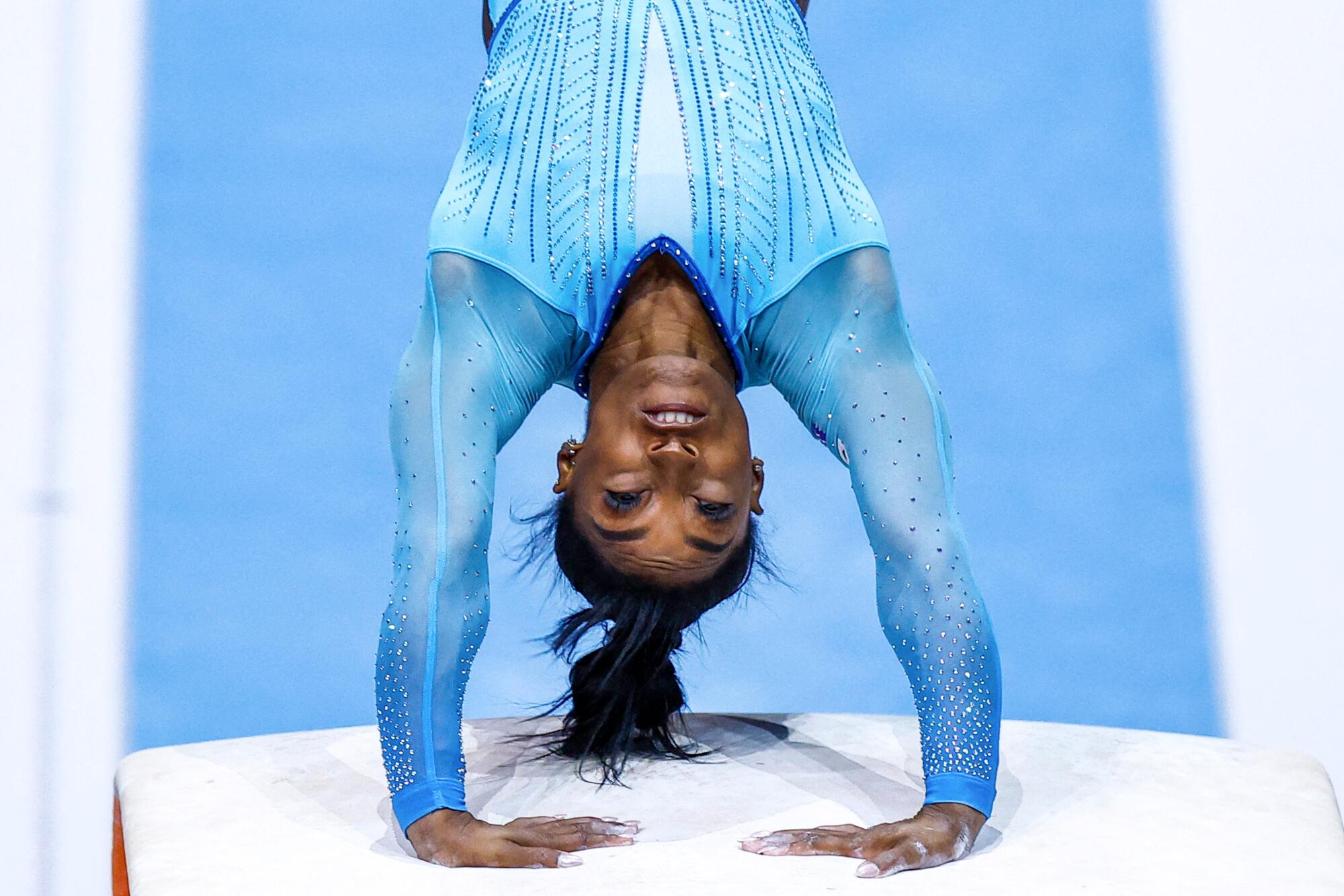
Aly Raisman had a front-row seat to the world’s best vaulters. The two-time Olympian watched 2012 Olympic teammate McKayla Maroney nail a nearly perfect two-and-a-half twisting Yurchenko in the team final. Raisman was also the team captain in 2016 when Biles won Olympic gold on vault. Both standouts shared a key ability that helped them soar above the competition.
“When you look at her elbows on the table, they’re always very straight,” Raisman said. “Their body was so tight when their arms hit the table that it just helps them get so much air.”
The moment Biles’ hands strike the table, she extends through her shoulders in a motion that’s barely detectable in real time. The micro-movement lasts a tenth of a second as Biles applies force to the vault that is then returned in equal and opposite measure. Keeping every muscle contracted during the split second on the table is vital to transferring energy efficiently for maximum height.
“The force gets dispersed in bad form,” said Gina Pongetti, a physical therapist with more than 20 years of experience working with college, national team and elite gymnasts. “[The muscles] are all tight at one time so that nothing gives, nothing buckles. Because of that, all of that force, or as much as possible, goes into the vault [and] goes back to her to transfer to height and rotation.”
NBC estimated that Biles’ feet reach about 12 feet in the air at the peak of her vault when she is upside down.
Former UCLA gymnast Nia Dennis knows the feeling. The three-time U.S. national team member trained a Yurchenko double tuck — with her knees bent and legs pulled toward her chest — into the foam pit during her elite career, eventually stacking up soft mats to be equal to competition height. While she is best known for her viral, energetic floor routines, Dennis loved vault the most. She still recalls the intoxicating feeling of hitting the perfect block that fired her into the air.
“I just felt like a cannon,” Dennis said.
The flips
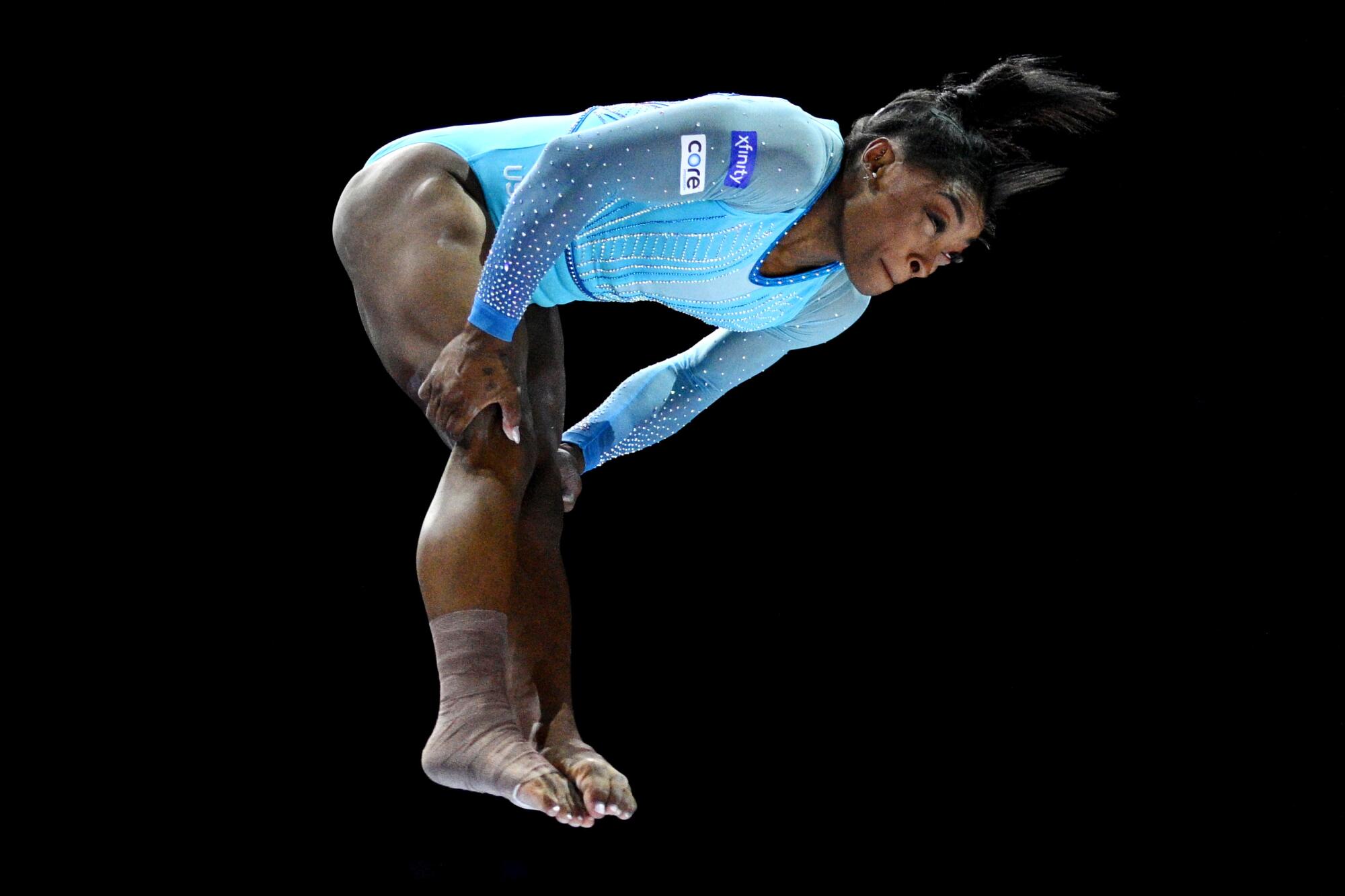
Searching for ways to upgrade her vault difficulty, Dennis wanted to buck the trend of adding additional twists to her Yurchenko. She was always more of a flipper than a twister, and Dennis sometimes landed on her neck from over-rotating her warm-up drills. One day, her coach encouraged her to pull all the way around onto her feet for an additional flip.
“It was just straight power,” Dennis said. “All I had to do was run and close my eyes, for real. Just block really hard, close my eyes really hard and pull really hard.”
For Dennis, the daring skill was fun. Her former UCLA teammate Ross did not share the sentiment.
“I used to like, cry because I was so scared of it,” laughed Ross, who practiced Yurchenko double tucks into the foam pit alongside her longtime club teammate Maroney.
The second flip is what makes the vault so frightening for athletes. Gymnasts can adjust a twisting vault midair by reducing the number of revolutions by halves if they feel something gone awry. There is no safe Plan B between one and two flips.
After Biles blocks off the vault, she is just a projectile, Kuhn emphasized. At that point, there is nothing she can do to change how high she is or her path through the air.
Fresh off leading UCLA to back-to-back NCAA titles, John Speraw is hoping to tap the U.S. men’s volleyball team’s gold potential at the Paris Olympics.
That’s when her proprioception takes over. Biles’ air awareness is “unbelievable,” Pongetti said. The physical therapist, who specializes in treatment, diagnoses and biomechanics in gymnastics, has watched Biles train for years.
While she cannot change her flight path, Biles is an expert in making split-second decisions to rearrange her body midair to change how she will move. If she is too low, she can pull her body into a tighter shape to flip faster. If she is too high, she knows a more open shape can slow down her flip and help avoid over-rotation.
Only that caliber of spatial awareness can make the death-defying skill “safer,” Pongetti said. She would never say it’s “safe.”
“That sets apart the level 10 [gymnast] from the elite,” Pongetti said, “from the Olympian from Simone.”
The landing
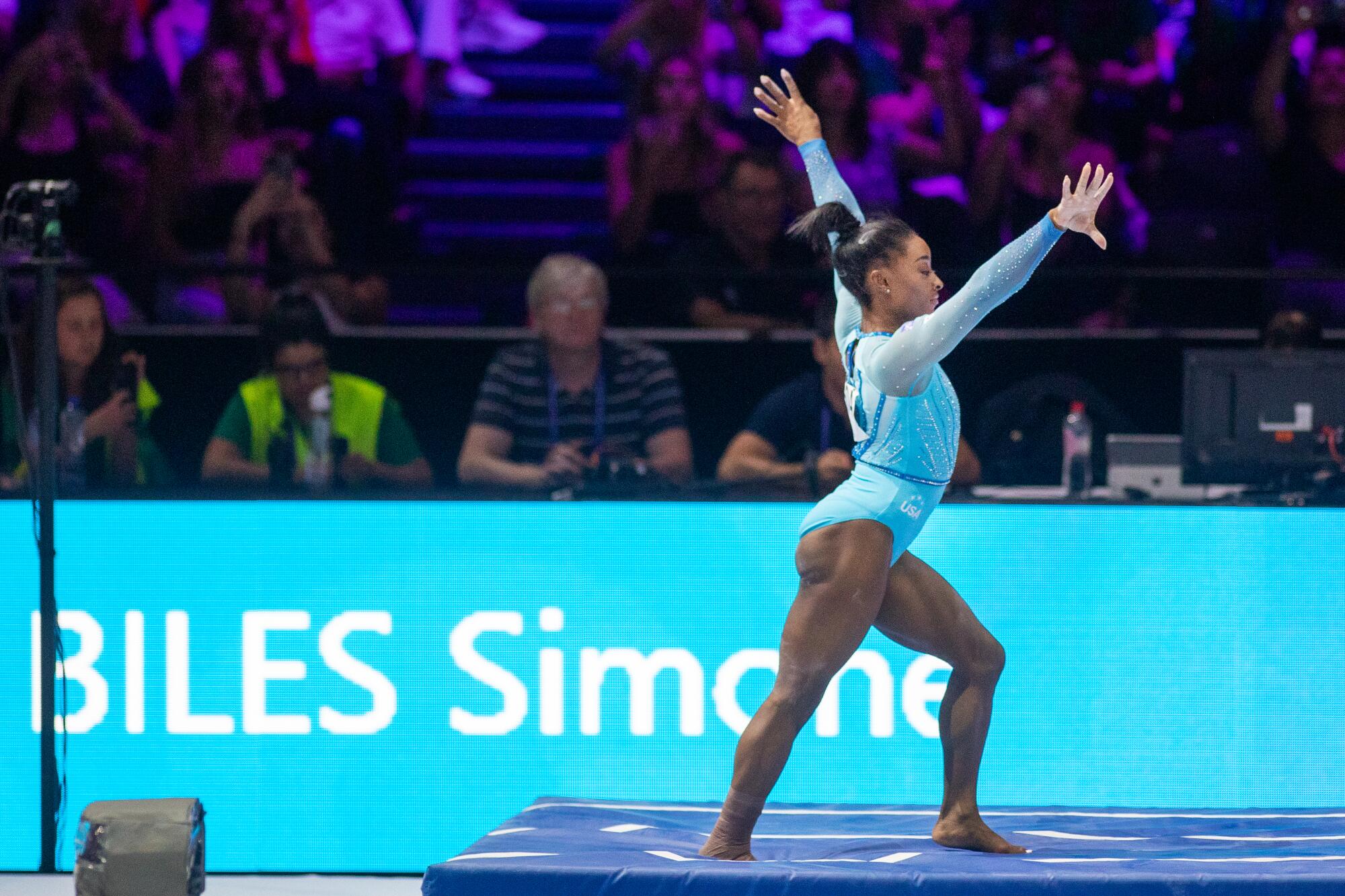
With five skills named for her in the code of points, Biles is at the forefront of the sport’s progression. Peszek remembers when the double-twisting, double back tucks she and 2008 Olympic teammate Shawn Johnson competed were arguably the hardest tumbling passes in the world. Now Biles casually does that skill in combination with a full-twisting front layout.
“It’s really special to see the generations pass the torch and just how they’ve been able to take this sport by storm by creating all these new elements and really pushing the boundaries,” Peszek said. “Seeing her do it so effortlessly, it’s really a work of art to see.”
The Biles II was awarded the highest-difficulty score of any vault by the FIG at 6.4. Astronomical-difficulty scores, which are combined on each event with an execution score out of 10, allow Biles to win competitions by whole numbers as most of her peers fight for half-tenths.
On vault, most of the top medal contenders have difficulty values of 5.4 for the two-and-a-half twisting Yurchenko known as an Amanar or 5.6 for a Cheng, which begins with a roundoff onto the springboard, a half turn onto the vault table and a one-and-a-half twist off.
Political upheaval and other issues plaguing Paris ahead of the start of the Summer Olympics threaten to dwarf whatever is floating in the Seine.
But Rebeca Andrade could challenge Biles for the crown. The Brazilian Olympic confederation published a YouTube video that featured the Olympic and world vault champion training a triple-twisting Yurchenko. If she lands it in international competition, it will bear her name.
Biles considered the skill as the next Yurchenko progression from an Amanar but has said going for the double flip was safer for her to land. The landing on a twisting flip presents additional challenges, Kuhn said, as gymnasts must absorb rotational forces to stop the twist while also controlling the landing vertically.
A 2013 study estimated that gymnasts absorb 11 times their body weight on landings during competition. The force increases to 18 times body weight if a landing is uneven, a common consequence of twisting elements. What Biles feels when her 4-foot-8 frame is falling from more than two and a half times her height to land the Yurchenko double pike might be even greater, Pongetti said.
“Her quads and her glutes and her hamstrings [and her calves], which otherwise would work to allow her to jump high, work in reverse to slow her down,” Pongetti said. “They are her brakes. … She is so good at not being stiff-legged when she lands.”
Fans seem to hold their breath as Biles floats and flips through the air. At the moment her feet punch into the mat, the crowd exhales with a roar of applause.
Thousands in Paris’ Bercy Arena will see the vault’s official Olympic debut. Millions more will watch internationally.
They’ll see Biles push the boundaries of sport and science in a gravity-defying six-second burst.
More to Read
Go beyond the scoreboard
Get the latest on L.A.'s teams in the daily Sports Report newsletter.
You may occasionally receive promotional content from the Los Angeles Times.

